Mazda New Zealand extended the team at DriveLife the opportunity to join them in Auckland for the launch of their first battery electric vehicle, the all-new Mazda MX-30.
Although slightly late to the EV party, the MX-30 is not just a milestone for Mazda introducing their first battery electric vehicle (BEV), but also the MX-30 foreshadows Mazda’s considered approach to sustainability within the automotive world.
We hear it nearly every day; the electric revolution is beckoning. Whether it’s a report of the latest technology advancements, another government committing to banning internal combustion (ICE) or that yet another car company committing to only electric vehicles by some date in the coming decade.
While you could describe these goals as admirable, Mazda would argue that the feasibility of these lofty goals is questionable.
As painful as it is to admit, there are still inherent problems with widespread adoption of electric vehicles. There are still many valid questions regarding product life cycles, charging and power infrastructure, and even technological suitability which have yet to gain a consensus.
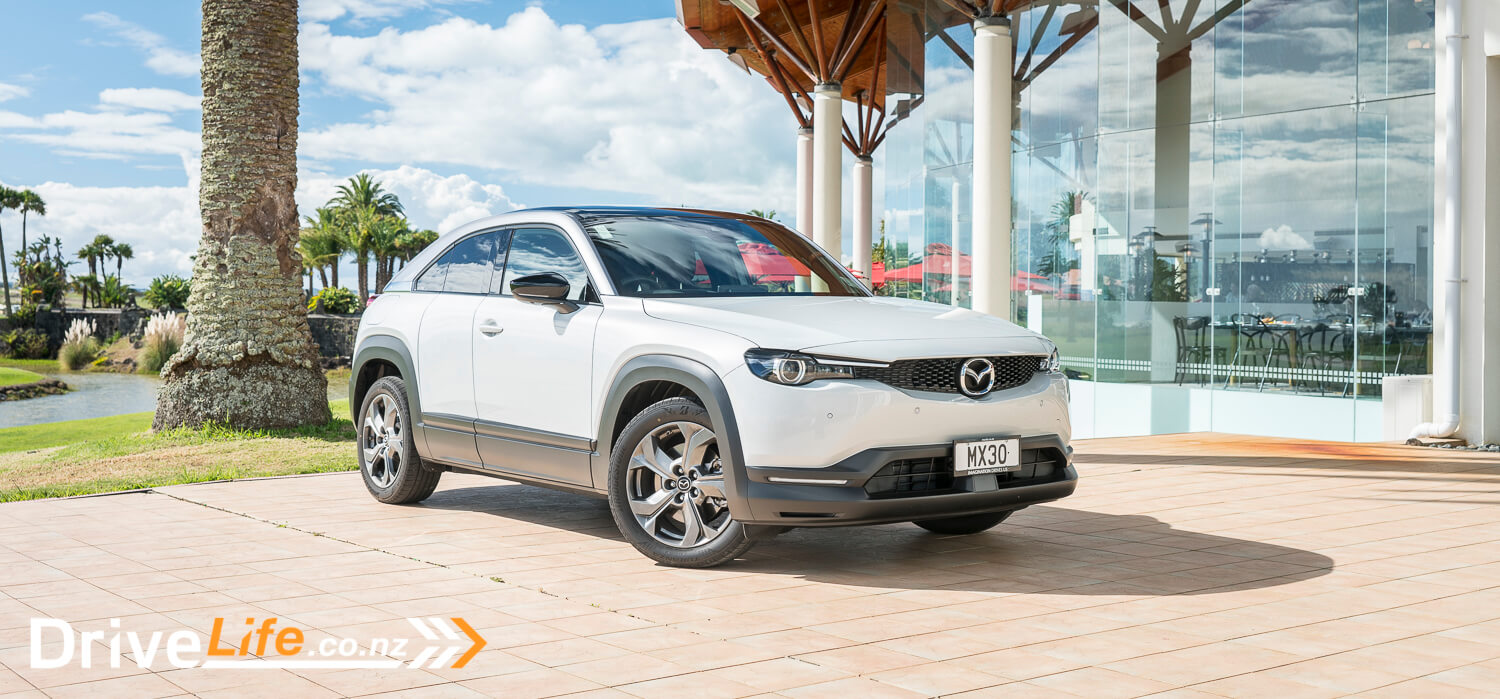
Mazda knows this, and therefore doesn’t believe in a silver-bullet solution. Instead, Mazda claims they’re looking at a holistic approach to sustainable vehicles. This means committing to a range of vehicle types, including BEVs, plug-in hybrids, diesel and gasoline hybrids, and even perhaps utilising synthetic fuels and rotary-driven range extenders for their future models. Part of Mazda’s plan also means considering the impact of their vehicles from raw material extraction through to recycling.

The multi-faceted approach is all to help Mazda achieve its goal of a 50% fleet emission reduction by 2030, with the aim of reaching carbon neutrality by 2050.
Mazda also firmly believes that driver engagement is a priority, which is music to our ears in an era where the driver control is being incrementally removed.
Therefore, the MX-30 represents the tip of the technological iceberg for Mazda, which demonstrates a meaningful step for the brand towards combating climate change.
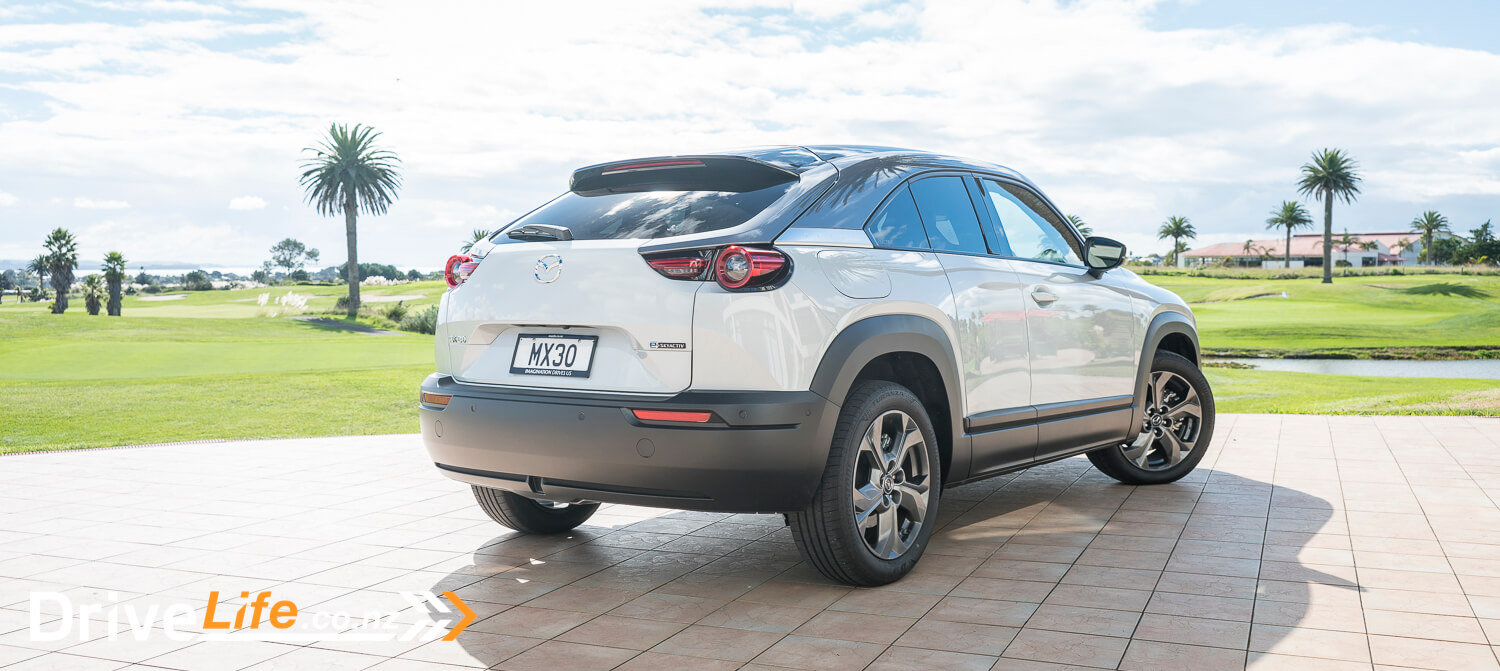
Onto technical details, the MX-30 leads the introduction of Mazda’s e-Skyactiv electric drive technology. The front-wheel-drive powertrain combines an AC synchronous electric motor with a water-cooled 35.5kWh lithium-ion battery. The combination delivers a driving range of 224km (NEDC) and performance figures of 107kW of power and 271 Nm of torque. This means the MX-30 will accelerate from 0-100km/h in 9.7 seconds.
On paper, around 200kms of range doesn’t sound compelling. However, this was a deliberate decision by Mazda, and arguably a meaningful one.
With current production processes, the upfront environmental cost of manufacturing a new BEV has a considerably greater carbon footprint over producing an internal combustion engine vehicle. This is largely due to production of the batteries.
Over the lifetime of an EV, there’s an anticipated break even point where the BEV becomes more environmentally friendly to run. However, the larger the battery, the long it takes for this break-even point to be reached. Therefore, a smaller battery has a smaller (up-front) environmental cost to produce, and therefore emission reductions are theoretically recognised earlier.
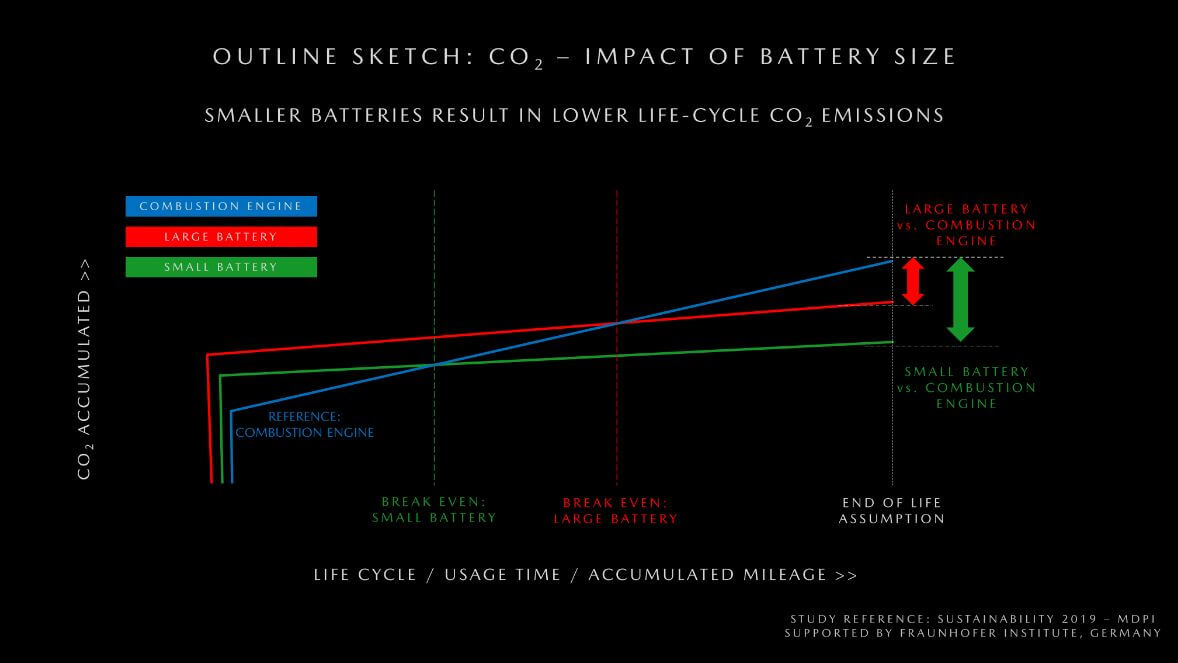
But what about range? The average Kiwi commutes around 28kms daily. DC charging brings the MX-30 from 20% to 80% in roughly 40 minutes. The trade-off for lower total range is a vehicle which is better for the environment. If you require that extra juice, a range extender option for the MX-30 will likely arrive in the near future.
This brings us onto pricing. The MX-30 is initially due to land in New Zealand in one-spec, the MX-30 Takami, with a RRP of $74,990. Early adopters will also gain a free home Wallbox charger valued at $2,000. Mazda also adds a 5-year warranty, 5-year Roadside Assistance and an 8 year/160,000km battery warranty. To top it-off, Mazda will also plant five trees for every MX-30 sold.
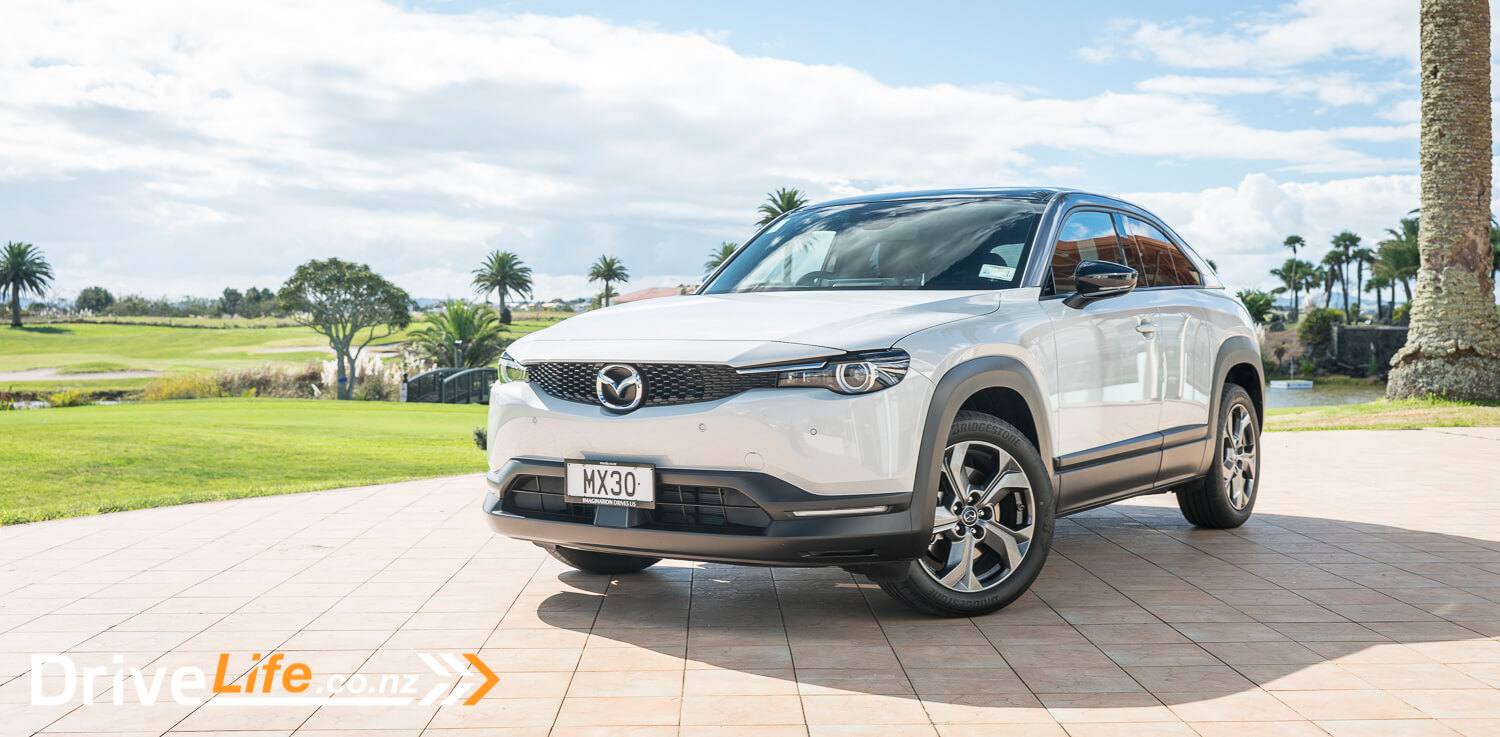
After our technical presentation at Mazda’s Auckland head-office, we were introduced to the MX-30 for the first time. We’ve seen photos from overseas before, but you’ll only appreciate the MX-30 more in the flesh.
There’s clear design continuity with the rest of the line-up, with the MX-30 employing Mazda’s Kodo design language. The result is a compact SUV which is clean and elegant, without screaming in-your-face about being an EV.
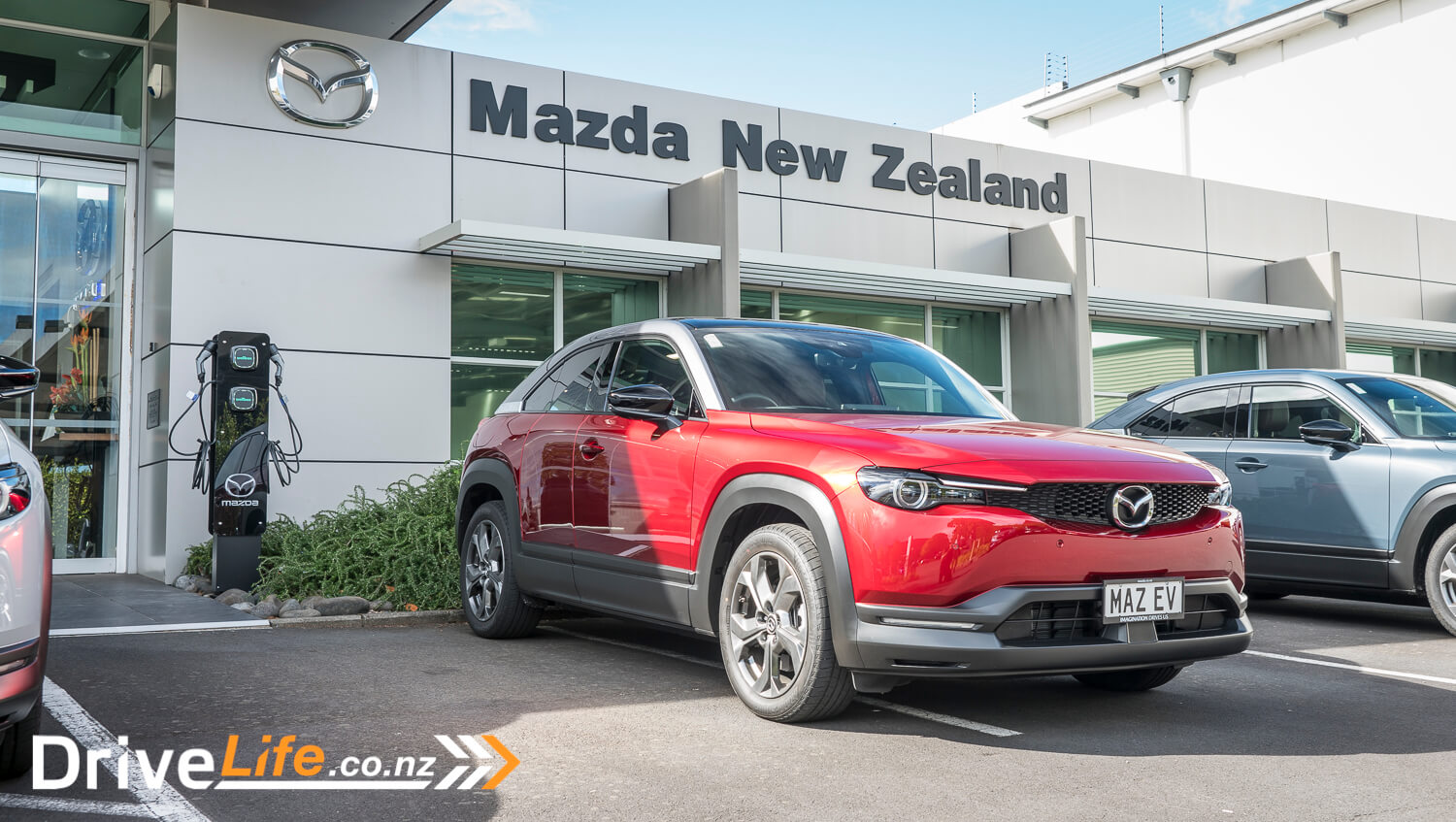
I also really appreciate the RX-8 inspired suicide doors and the stainless-steel Mazda plaque sitting atop the C-pillar. Our test vehicles wore a range of multi-tone colours, and each car looked sharp. Ultimately, the design speaks for itself. You needn’t know anything about the drivetrain to know that the MX-30 is a premium vehicle.
On the subject of premium, Mazda has been totally spoiling us with the quality of their interiors as of late, and the MX-30 is no exception. Although the straight lines of the interior might seem conservative compared with the design of the Mazda 3 and Mazda CX-30, where the MX-30 stands apart is with its cabin materials. The MX-30 uses vegan leather (leatherette), and PET fabric which is made from recycled plastic bottles. Cork also lines the centre console and door handles, which is a nod to the company’s history.
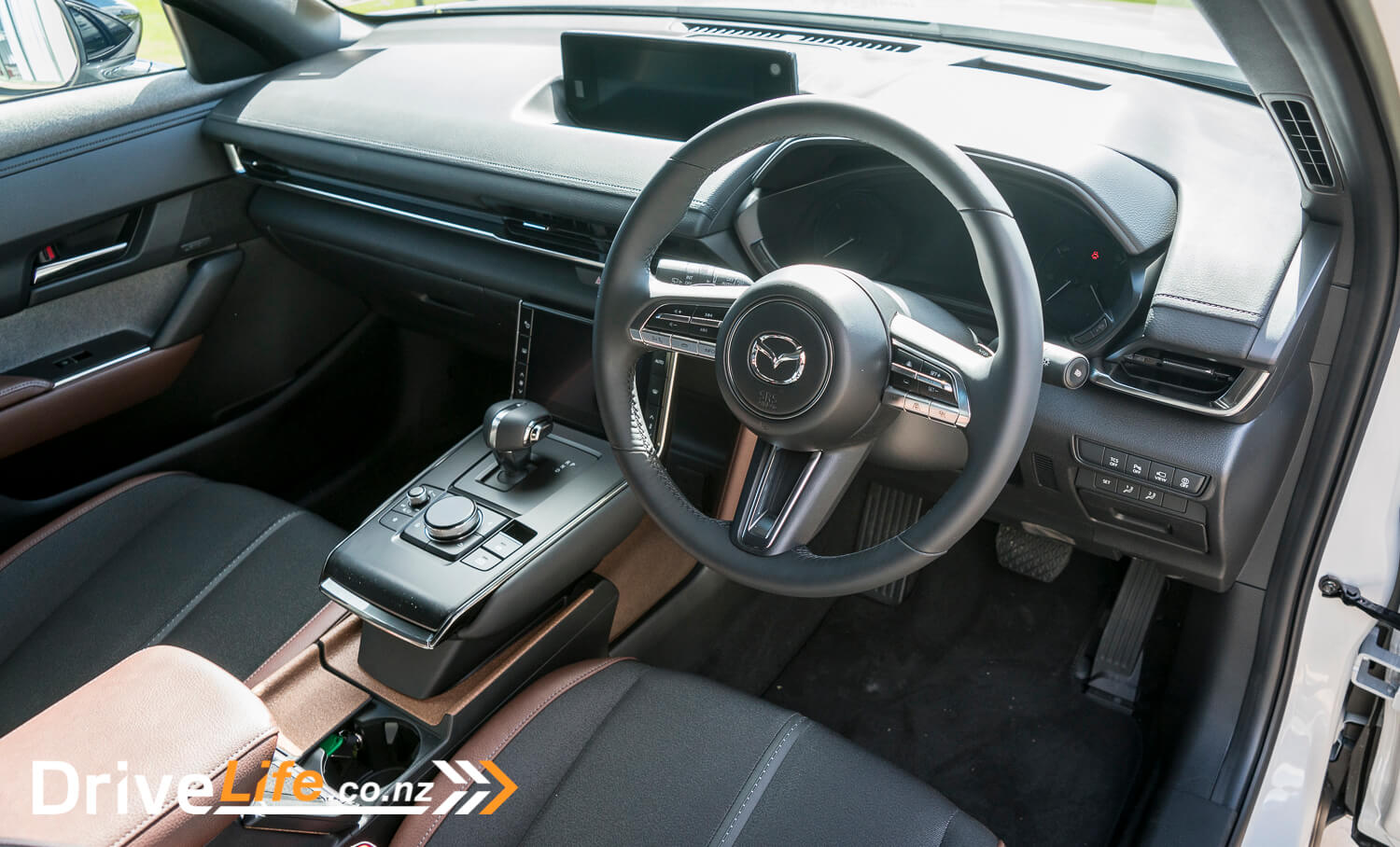
Cork was the first product Mazda produced when the company was founded over 100 years ago. Back then, I am not sure the founders could have ever envisioned where the company would be today.
The MX-30 has all the mod-cons, including a heads-up display, touch-screen climate controls, heated seats and steering wheel, plus a 12-speaker Bose Audio System.
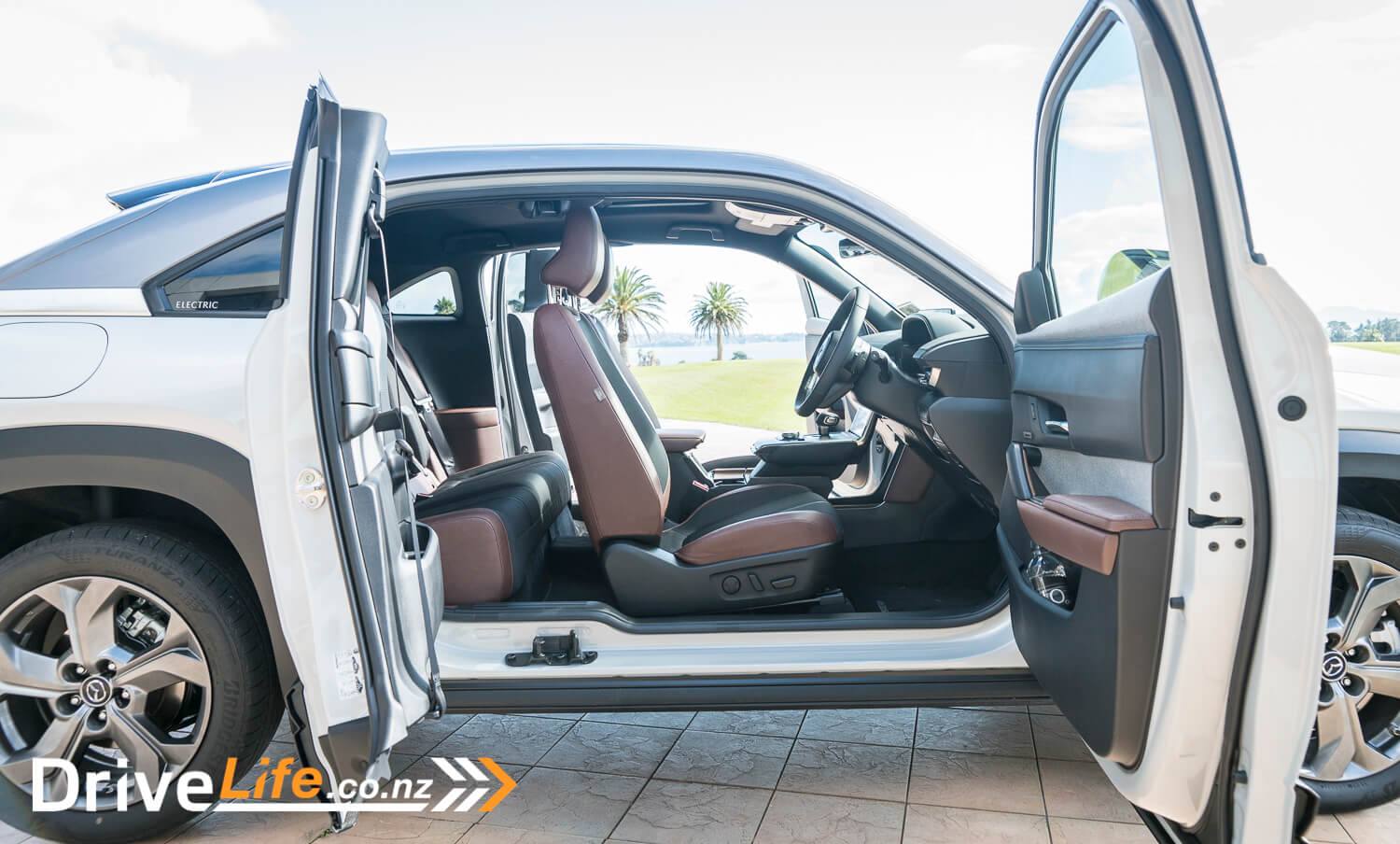
With the introduction complete, it was time to embark on our drive from Mazda’s headquarters to Beachlands via Maraetai.
Mazda devised a route of motorways, rural roads and twisty-back roads to get a proper taste of the MX-30’s capabilities. Mazda’s often better their competitors with their ride quality, yet where the MX-30 surprised the most was on twistier sections.
Given that the MX-30 uses a smaller battery, its weight is on the lighter end of the spectrum for an EV at 310kg. It’s roughly the same weight a base Tesla Model 3. Combine the relative lightness with a low centre of gravity from the floor mounted batteries, and you get a small SUV which you have a bit of fun with through corners.
Some EV’s can feel like a relentless hurtling mass when driven quickly, yet the MX-30 didn’t.
While the handling was the unexpected surprise, the ride quality on the open-road is also good. Mazda’s G-Vectoring Control technology is also employed on the MX-30. We’ve spoken about this system before in glowing terms in our Mazda 3 and CX-30 review(s).
Being an EV, there are also five levels of regenerative braking, controlled via the paddles on the steering wheel. Set the regen to its strongest, and the MX-30 effectively becomes a one-pedal car aside from reaching a standstill.
Fred’s Perspective
After having driven the MINI EV earlier this year, the MX-30 was one new EV that I was dying to get into. Like many, I had seen the YouTube clips of the car, and it all seemed very Mazda-like; a quality interior, looks that aren’t too out there for an EV, and a great driving experience.
We’d come to love driving – actually driving – cars like the Mazda3 and CX-5, so I was desperately hoping the MX-30 wouldn’t disappoint. After all, Mazda is all about driving cars, not just getting from A to B.
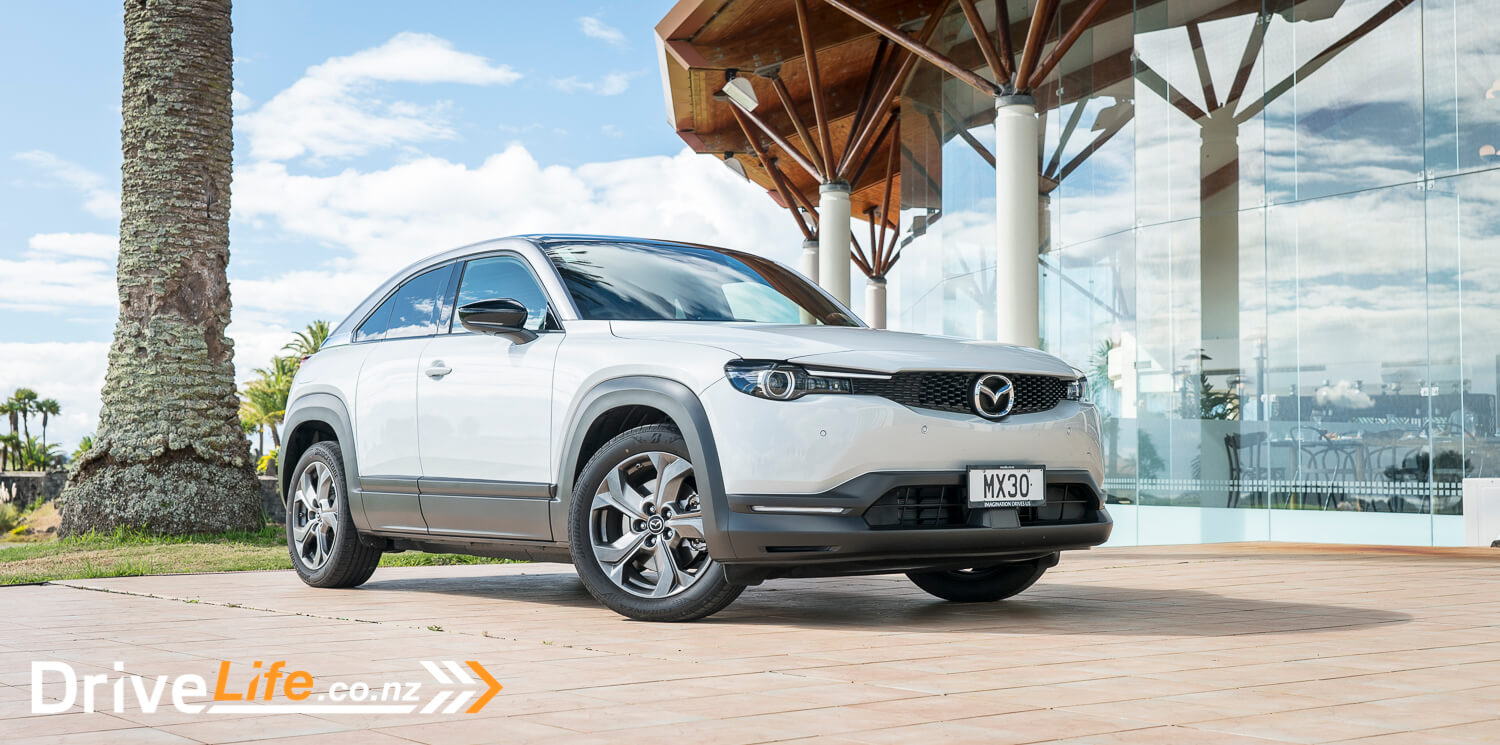
The first kilometre in the car really cemented it for me – this car is 100% Mazda. It looks even better in the flesh than in the pics – especially in Soul Red – and still looks like a Mazda. Thankfully, the company has not gone all weird on it, and the only radical change from their standard design cues are the ‘Freestyle’ doors. I love these doors – and I think any car guy or girl would – and they have the bonus of being quite practical. I could almost imagine I was in an RX-8, except for the blat blat from the exhaust.
Well, there is that fake car/engine noise of course, but I like it. There are some fake engine noises out there in EVs (cough! I-PACE cough!) that just sound bad all over. Not so in the MX-30, which is lucky as I don’t believe you can turn it off.
The whole car feels tight, and driving it is a familiar experience; other than the lack of engine noise, it drives like every other Mazda, and I am more than happy that they’ve kept a fuel gauge (which now of course reads the battery) a temperature gauge (battery temperature), and the almost-standard gear shifter. It’s touches like this that make this EV more ‘normal’ and so hopefully buyers will look at it as just another car, which it is.
With the pricing, the driving and the looks, Mazda should be selling all the MX-30s they can get.
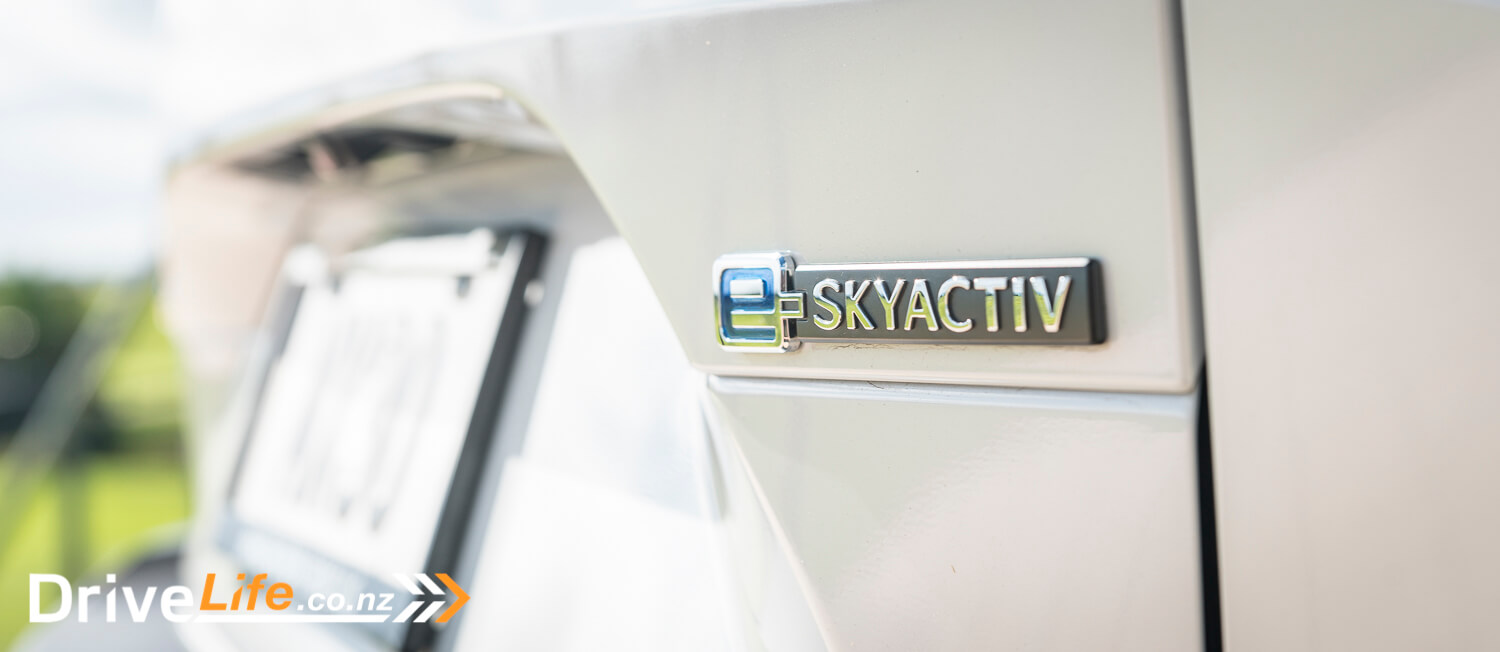
John’s perspective
I was not sure what to expect from the fully electric offering from Mazda. The new MX-30 was a step in a different direction for them, a step that ensured they would keep their pulse on the global trend. It’s true that many others have come to market with EV’s that are already available in New Zealand. But you don’t always have to be the first out of the gate, sometimes it’s better to sit back, and see what does and doesn’t work, which is what Mazda has done with the MX-30.
For a start the new 2021 Mazda MX-30 does not look like an EV. That’s a step in the right direction, as many of us don’t like the try hard to be different designs. They have achieved this by keeping with the strong design language currently used in the rest of their range. It fits in, while having a sharp and funky look. I personally preferred the two tone looks, which gave it a modern edgy feel.
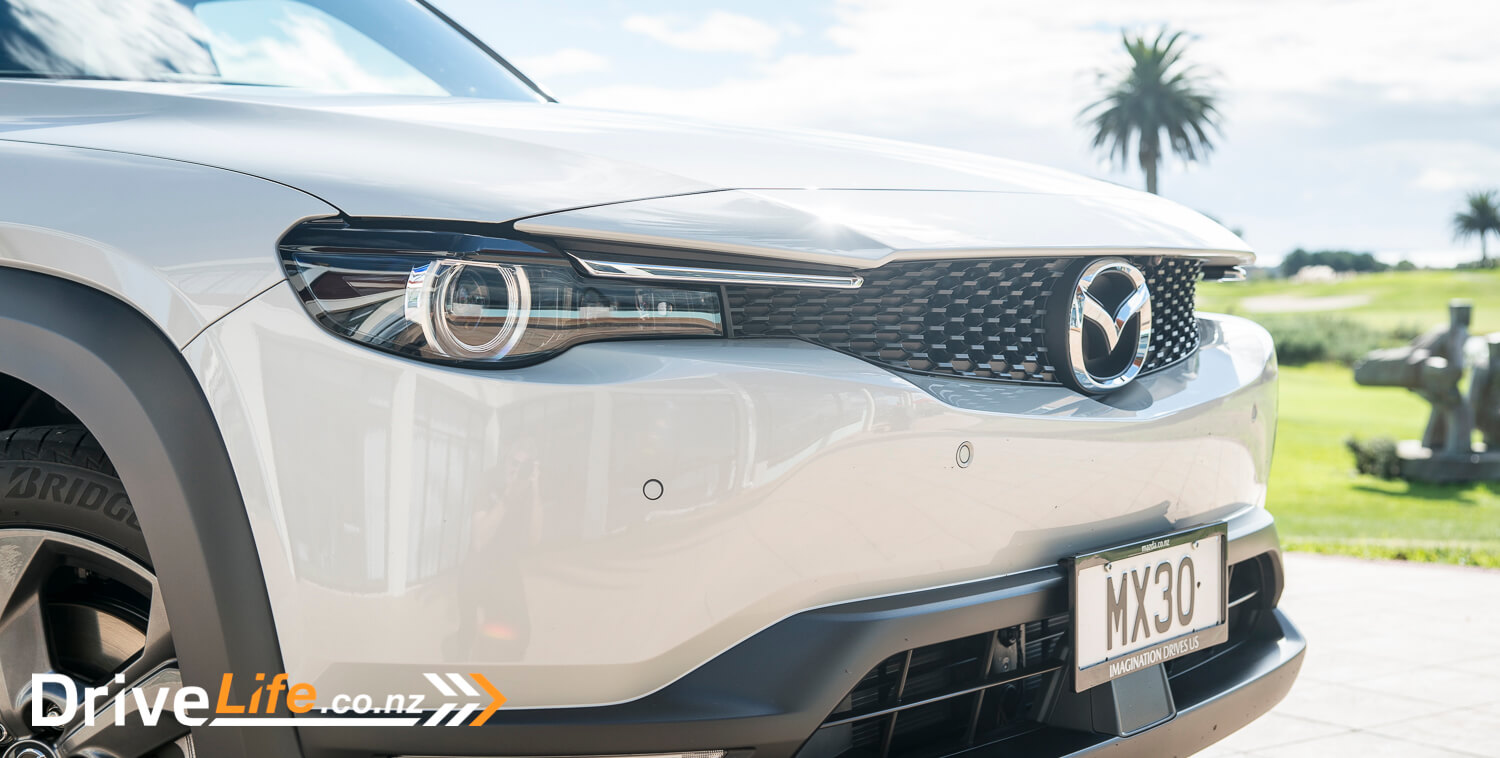
They also don’t want it to feel like an EV, they wanted it to feel like a car. The driver should feel as at home in the MX-30 as they do in their current or any typical internal combustion engine vehicle. They achieved this by having similar features in this EV as they do in their ICE vehicles. The gearstick, which lets you select drive modes. The speakers play a subtle EV motor tone that simulates engine driving when in motion (which I really liked). The dash which shows your speed, range and battery level, with gauges and dials that look and feel like standard dials. And the accelerator pedal, which provides a more linear power delivery, compared with other EV vehicles. Last but not least, they didn’t want the car to feel like a tool, they wanted to retain the enjoyment of driving. The MX-30 is sharp and precise for those who want to push it, paired with the battery weight low in the car you’re left with a vehicle that feels sporty and nimble on its feet.
The MX-30 was also designed for practical everyday life. The return of the freestyle doors brings a whole new level of flexibility to this vehicle. Essentially it’s removing the B pillar from the car, which allows easier access into the rear of the vehicle. I can see this being a game changer for new families, making life so much easier with young kids in child seats.
I really enjoyed my time behind the wheel of the new MX-30, I feel this car will be a big hit here in New Zealand, as they have kept it simple and customer focused.

Rob’s perspective
It was really refreshing to hear Mazda’s philosophy on EV development. So much recent messaging from car companies focuses on electrification itself, and engineering out the driver in favour of automation. Putting the tech ahead of the person.
Mazda, are on their Jinba Ittai path which focuses on building the car around the driver and the driving experience, and this continues with their first battery EV. Automation is present, but as a backup, a co-pilot, to help if the driver gets in trouble, or in situations where it’s not fun to do the driving yourself.
I love that they have made a conscious decision to limit battery size rather than jamming in the biggest heaviest battery they can and crowing about range numbers. Similarly with the way the motor has been tuned to give a more linear acceleration rather than chasing 0-100 times. And that huge space in the engine bay, ready to accept Mazda’s recently patented rotary range extender. Or maybe in future a hydrogen cell? Mr Fusion?
The MX-30 looks great. It has a proper front grille and face and is instantly recognisable as a Mazda. Similarly inside, it feels like a recent Mazda. Everything is where you expect it to be, everything feels premium. The new recycled materials look and feel fantastic and everything seems solid and well engineered. Open the rear Freestyle Doors and the rear looks quite small, but that’s misleading. It’s easy to get in and out and I had lots of head and knee room seated behind my normal driving position.
What about the drive? Well it’s an ordinary car, in the best way. No gimmicks, no fuss. Apart from the almost-silence you could be in any other Mazda. In motorway traffic the smart cruise did its job perfectly. The SatNav directions, spoken and shown on the HUD, were clear, the ride was quiet and well damped, and the Bose stereo was excellent.
On the hilly and twisty sections I was surprised at how light it felt. Bumps and dips were handled well, and you can definitely have fun with the MX-30 on a twisty road.
Overall I was left with the feeling that this would be the perfect daily car for my family, and that’s the first time I’ve felt that with an EV
As you can tell, the MX-30 left a great first impression with us here at DriveLife. We’re eager to get their hands on an MX-30 for a full test. Thank you again to Mazda New Zealand and to those that supported us with our first experience the Mazda MX-30.
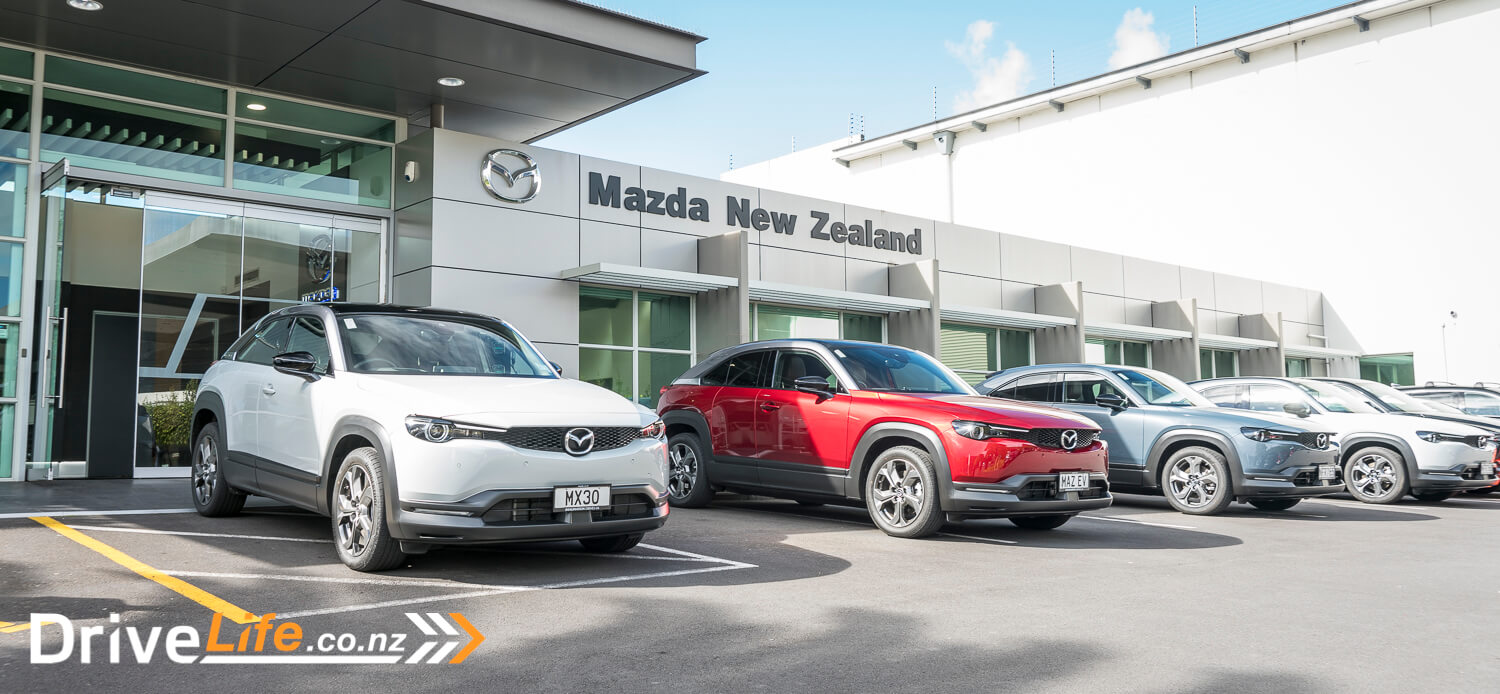



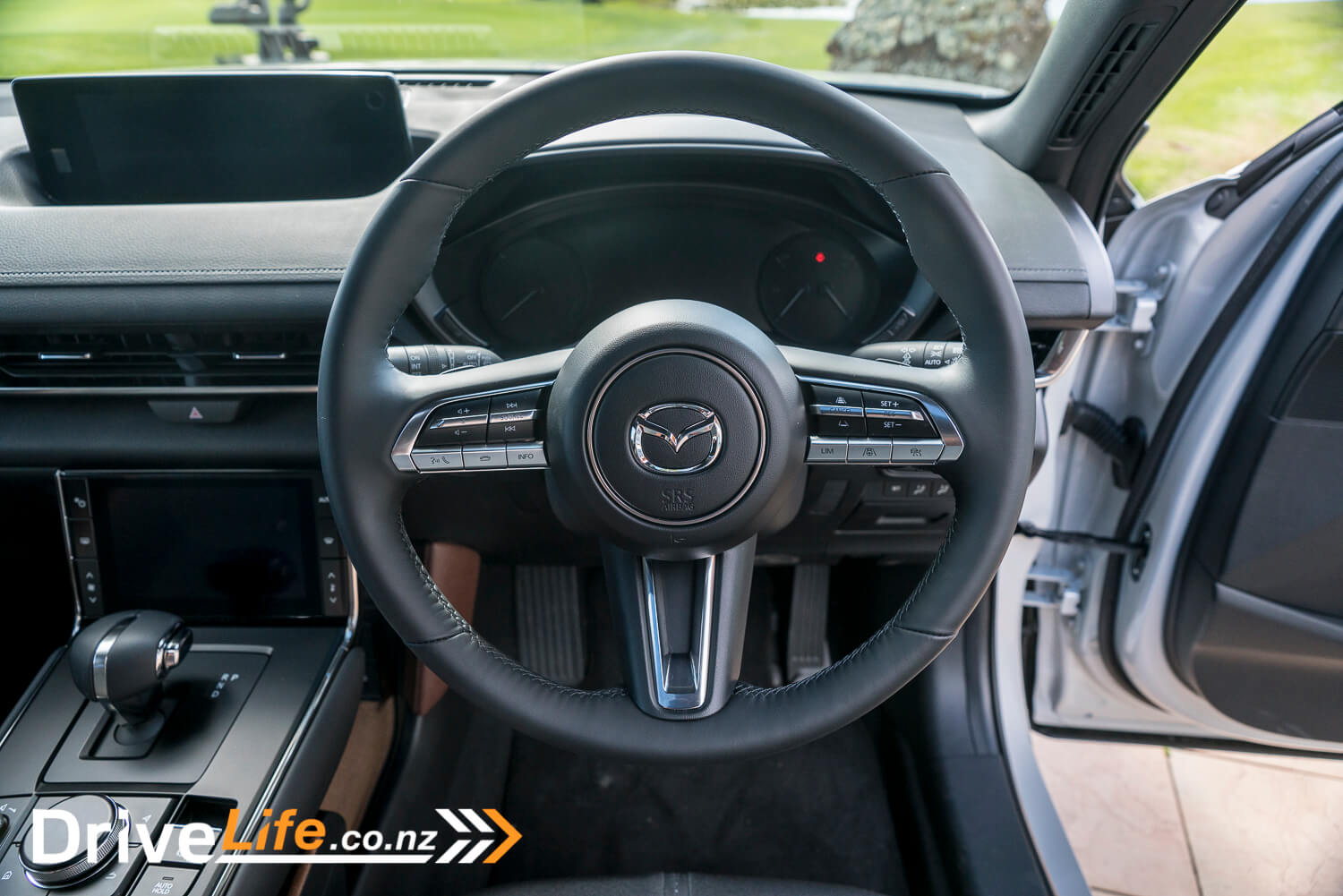

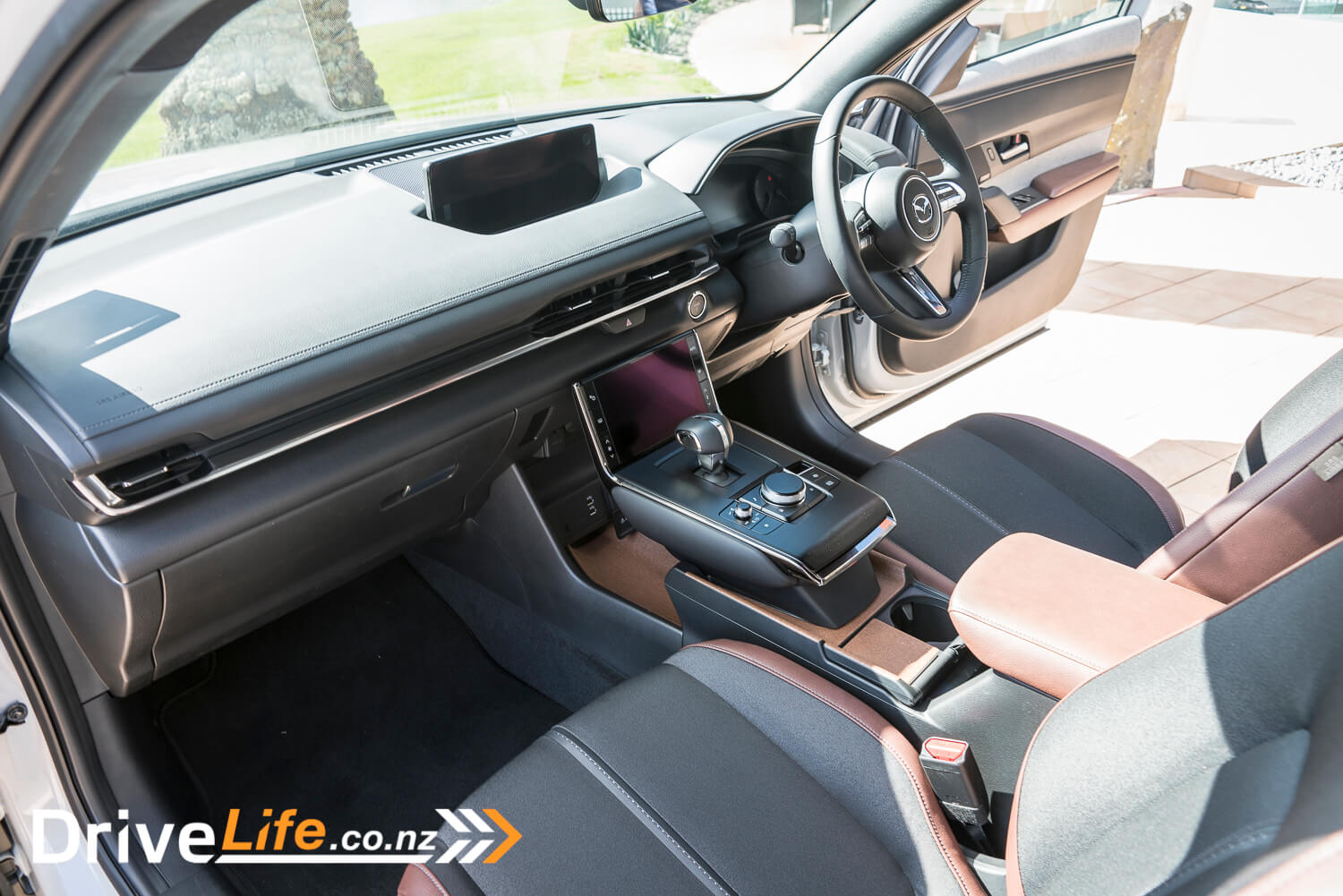
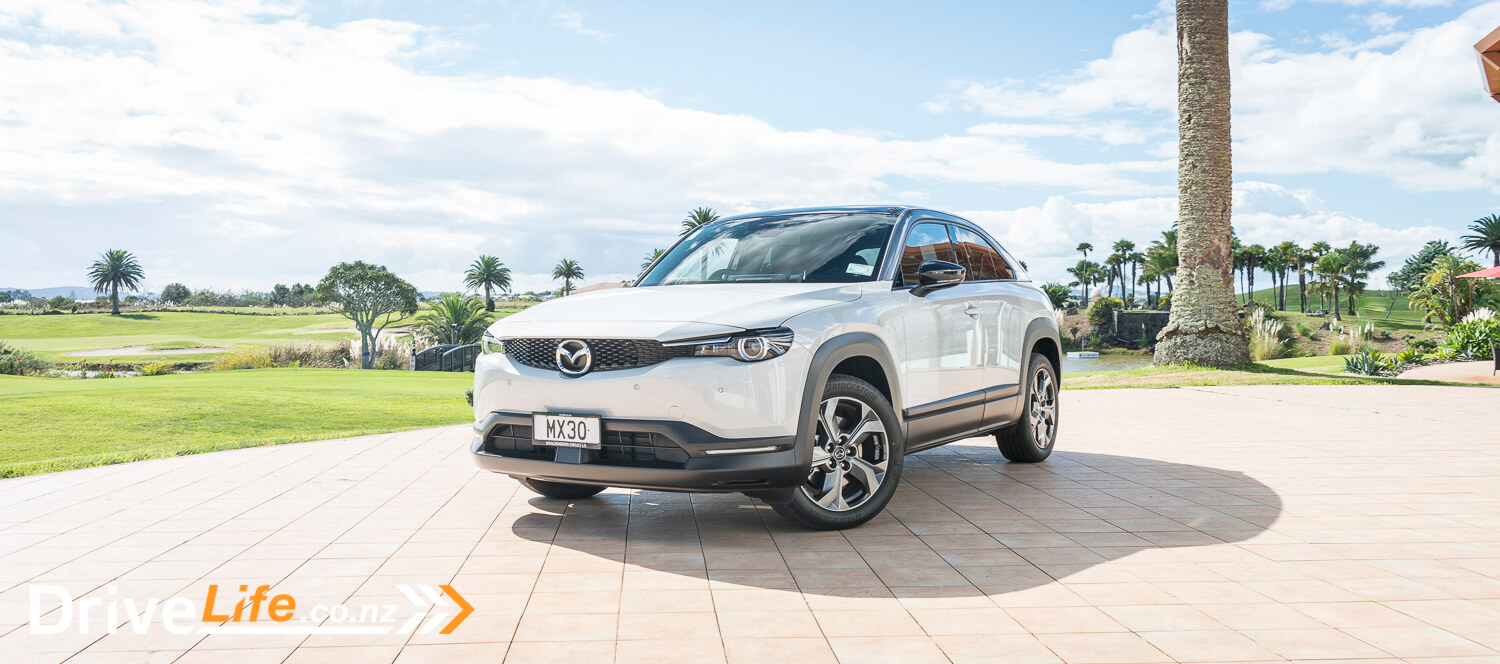
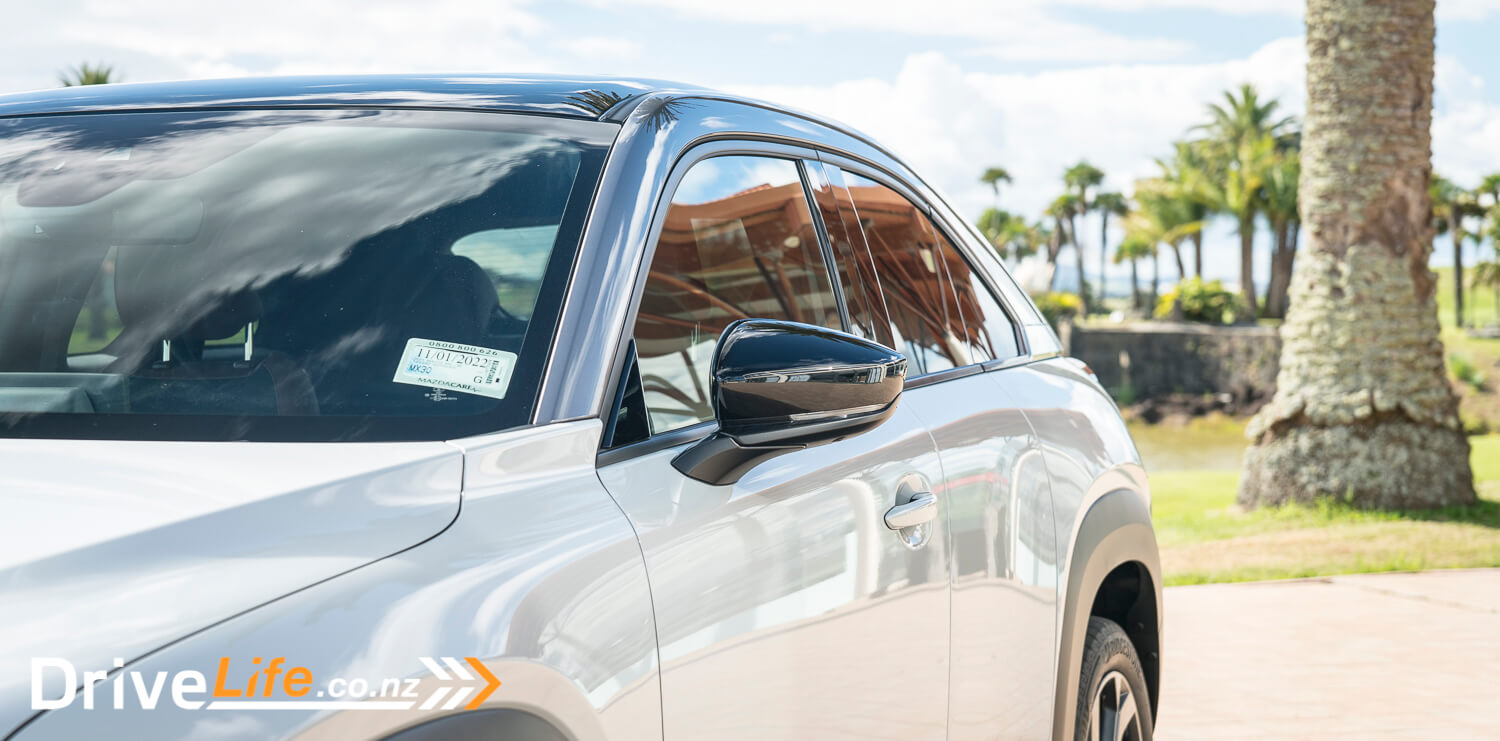
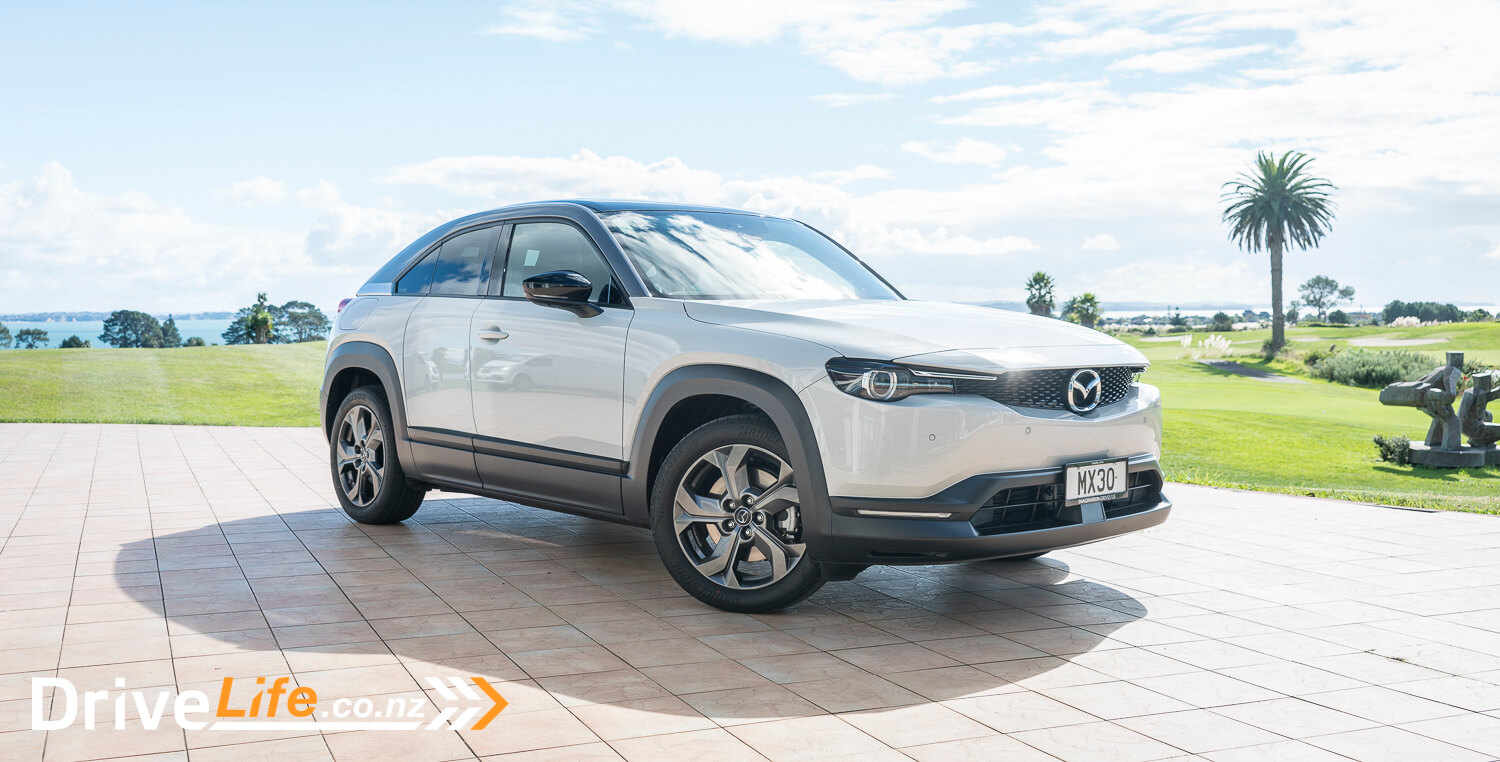
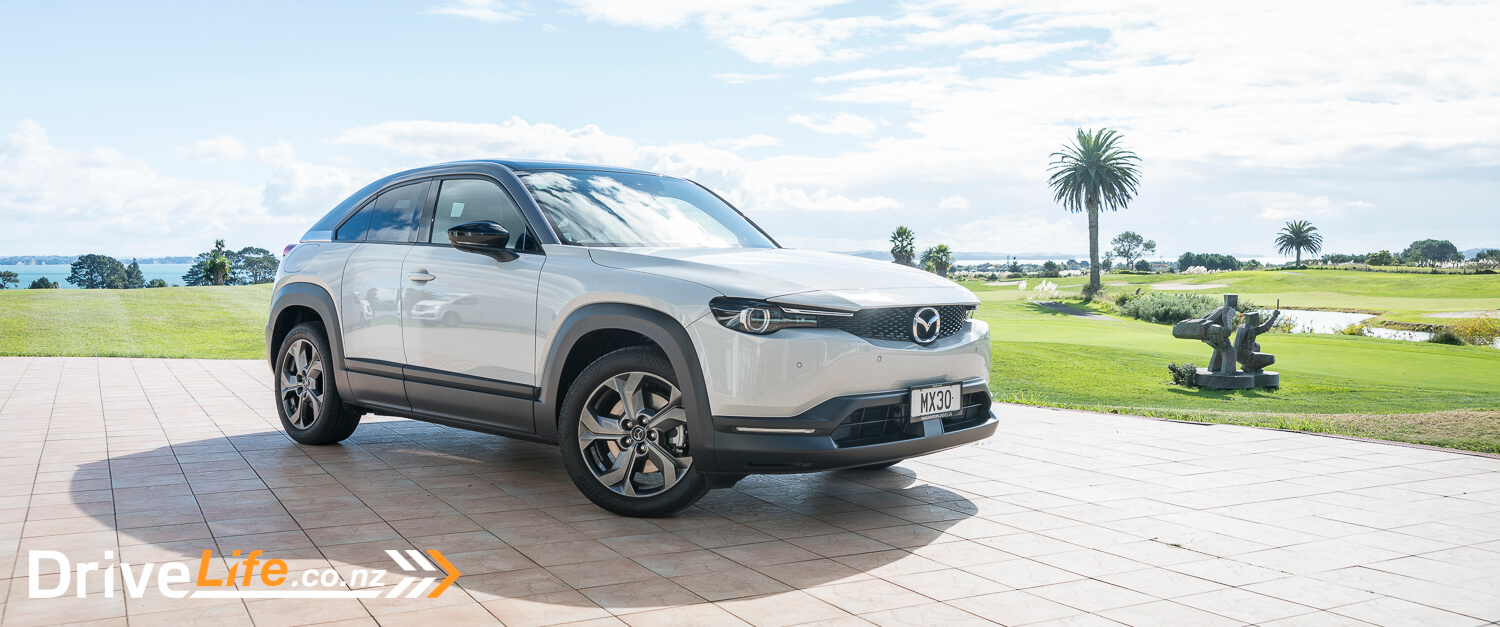
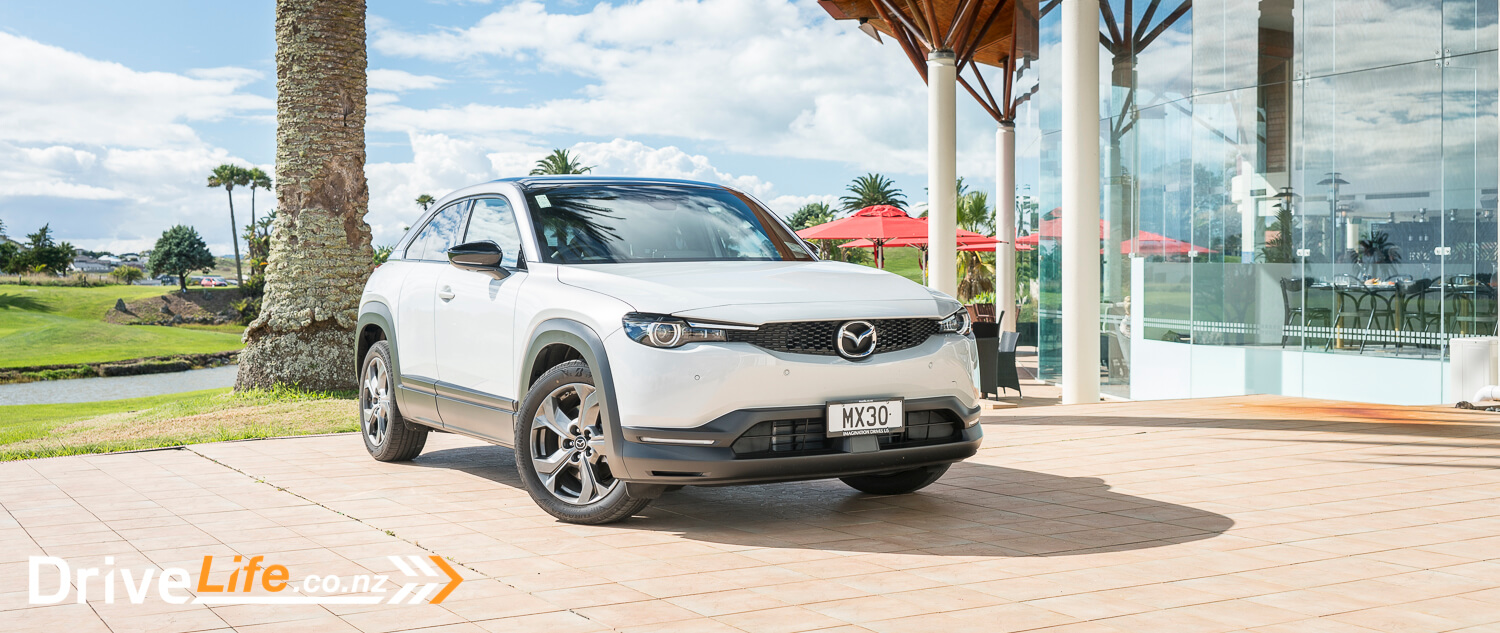
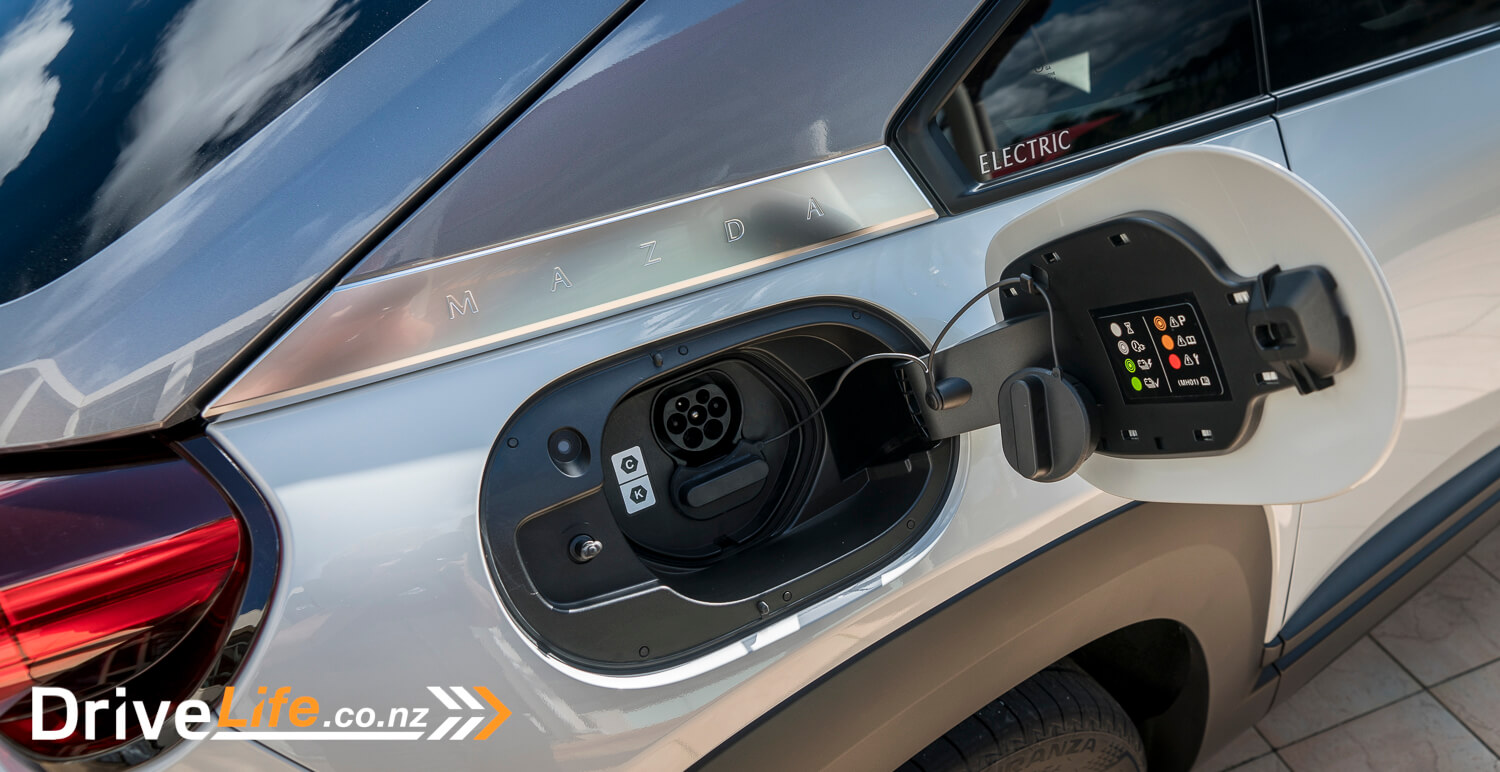
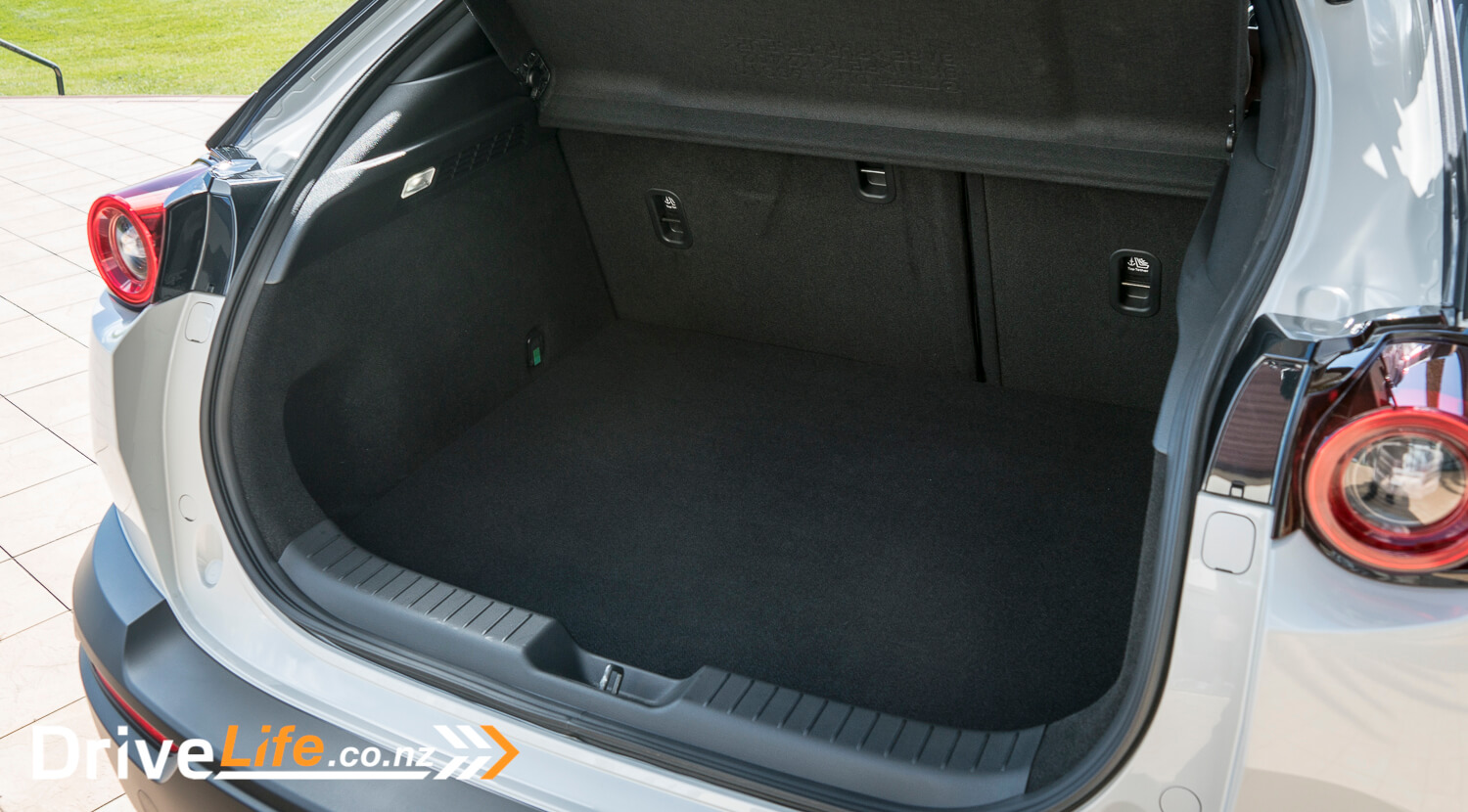












































I’m not sure their motivation for less than adequate range for an exorbitant price is the environment unfortunately. Might be good to find some recent studies on battery environmental cost / CO2 etc.
Gosh 200Km for $74,999. Really? This is not what I was hoping for from Mazda on any metric bar design. Is this a joke?
Are you actually impressed by this?